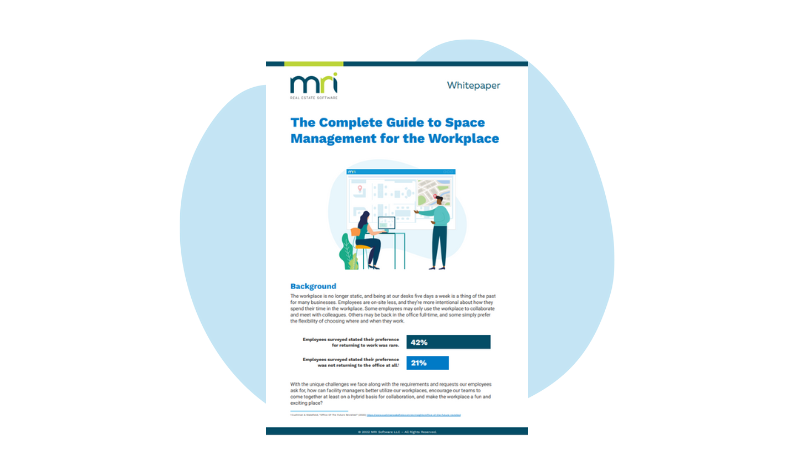What is a space management system and how does it work?
A space management system is a powerful tool used to optimise, organise and maximise the potential of spaces. Whether it’s a bustling office environment, a retail store or an industrial unit, the effective utilisation of space is crucial for productivity and efficiency.
In this post, we explore how you can optimise and organise your spaces efficiently with a space management system for enhanced functionality and productivity.
What is a space management system?
A space management system serves as a comprehensive toolkit for real estate professionals, enabling them to effectively plan, measure and optimise the utilisation of available space to ensure consistent workplace productivity and collaboration.
At its core, space management software provides invaluable insight into the dynamics of space usage within an organisation. It goes beyond mere square footage calculations, offering detailed analytics on how, when and why employees interact with the available space. Through advanced data collection and analysis, these systems empower decision-makers to make informed choices regarding space allocation, utilisation and optimisation strategies.
By understanding the patterns of employee behaviour and space utilisation, organisations can tailor their environments to meet the evolving needs of their workforce. Whether it’s adjusting seating arrangements, optimising meeting room usage or reallocating space for specific activities, space management systems provide the necessary tools to adapt and thrive in dynamic work environments.
How does a space management system work?
A space management system benefits organisations by operating as a comprehensive platform designed to streamline and optimise the utilisation of available space within an organisation. Key functionalities include:
- Centralised repository of data: These systems serve as a centralised hub for all space-related information, consolidating data from various sources and buildings into a single accessible platform. This eliminates the need for cumbersome data compilation processes and provides users with a unified view of the organisation’s space assets.
- Comprehensive space visualisation: Users are equipped with a holistic view of the space and how it’s being utilised by employees. This feature enables stakeholders to gain insights into occupancy patterns, traffic flows and spatial dynamics, facilitating informed decision-making regarding space optimisation.
- Efficient space booking: Space management systems empower employees to seamlessly book desks and rooms through various devices, including desk screens, room panels and mobile applications. This flexibility ensures that individuals and teams can reserve spaces for both individual and collaborative activities, enhancing workplace agility and productivity.
- Strategic space utilisation: Leveraging a central space inventory, these systems enable organisations to strategize their space utilisation effectively. They facilitate the creation of floor plans, seating charts and seating scenarios tailored to different teams’ sizes and needs. Moreover, they ensure compliance with safety regulations and prevent unnecessary expenditure on underutilised space.
Key features of a space management system
Space management systems offer a suite of features designed to optimise space utilisation, enhance efficiency and facilitate informed decision-making. Here are some key functionalities:
1. Visualise space utilisation:
- Central space inventory: Maintain a centralised repository of space data to edit occupancy floor plans for various seating scenarios.
- Neighbourhood and seating zones: Customise seating arrangements to accommodate the needs and schedules of different business units.
- Auto-physical distancing rules: Automatically identify restricted capacity to ensure compliance with regional and local regulations, promoting a safe working environment.
2. Streamlined booking process:
- Booking tools: Enable employees to easily reserve desks and conference rooms through intuitive booking interfaces.
- Touch-free check-in/check-out: Implement features like QR codes for touch-free check-in and check-out, enhancing convenience and safety.
- Visitor and employee check-in management: Pre-screen visitors to ensure only those verified can enter your building, with oversight into who is on site by tracking visitor and employee check-ins.
3. Real-time data-driven insights:
- Editable seating zones and diagrams: Dynamically adjust seating arrangements based on real-time occupancy needs, ensuring optimal space utilisation.
- Granular reporting: Generate detailed reports on seating usability segmented by different groups such as business units, floors or properties. These insights help identify usage trends and facilitate strategic decision-making regarding space allocation and layout adjustments.
What are the benefits of a space management system?
Space management systems offer numerous benefits for organisations looking to optimise their workspace and enhance operational efficiency. Here are some key advantages:
1. Efficient space utilisation:
- Manage and utilise space efficiently: Space management systems enable organisations to efficiently manage and utilise their space, ensuring that every square foot is maximised for productivity.
- Visibility into space utilisation: Gain insight into occupied and unoccupied space across properties, allowing space management teams to identify underutilised areas and redirect resources accordingly.
- Customise seating arrangements: To reflect the occupancy and collaboration needs of different business teams, fostering collaboration and productivity.
2. Reduce costs:
- Reduce unused space and equipment: By analysing key metrics, space management software helps organisations identify and reduce unused space, furniture and unnecessary workplace equipment, leading to significant cost savings.
- Optimise expenditure: Space management systems assist in optimising expenditure by identifying areas of inefficiency and reallocating resources based on real-time trends and usage patterns.
3. Real-time data and metrics:
- Access to real-time insights: Space management software provides real-time and historical insights into space utilisation, enabling organisations to make informed decisions and justify changes in expenditure.
- Workplace reporting: Compile data into comprehensive workplace reports, offering insights into historical, current and future space utilisation trends, facilitating strategic planning and optimisation efforts.
4. Effective management of hybrid workplace trends:
- Adapt to flexible work options: With the rise of hybrid work models, space management systems help organisations adapt by ensuring that spaces are properly utilised when employees are on-site.
- Enable flexible booking: Empower employees to book desks and rooms seamlessly across devices, facilitating a smooth transition between remote and on-site work.
Improve your efficiency with a space management system
Traditional methods of monitoring, assessing and adjusting your organisation’s space can be complex and time-consuming. The larger your organisation and the higher the number of workplace locations you manage, the greater the challenge. Each space, such as an area, room, floor or building, may have unique requirements, challenges and ultimately, different spaces to manage.
This is where space management software comes into play. You can ensure that your workspaces get used effectively and efficiently while still supporting your employees’ needs. Space management software provides helpful insights into how each space gets utilised, your occupancy and other analysis of the spaces your employees use. It allows you to make smart decisions about your spaces and what resources they require.
FAQs about space management systems
Software solutions and services for workplace management, lease administration and lease accounting.Workplace

The Complete Guide to Space Management for the Workplace
The workplace is no longer static, and being at our desks five days a week is a thing of the past for many businesses. Employees are on-site less, and they’re more intentional about how they spend their time in the workplace. Some employees may only …
